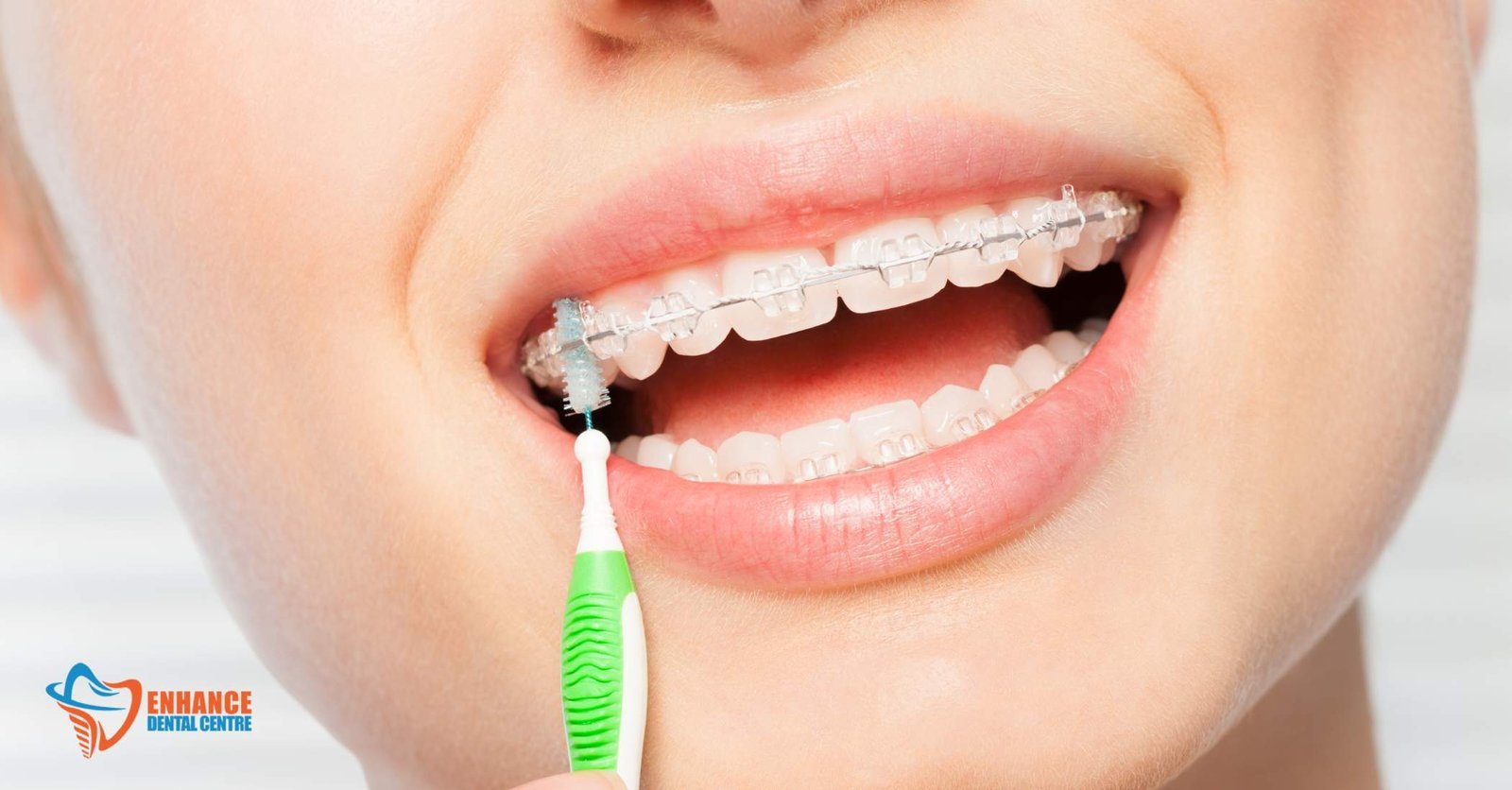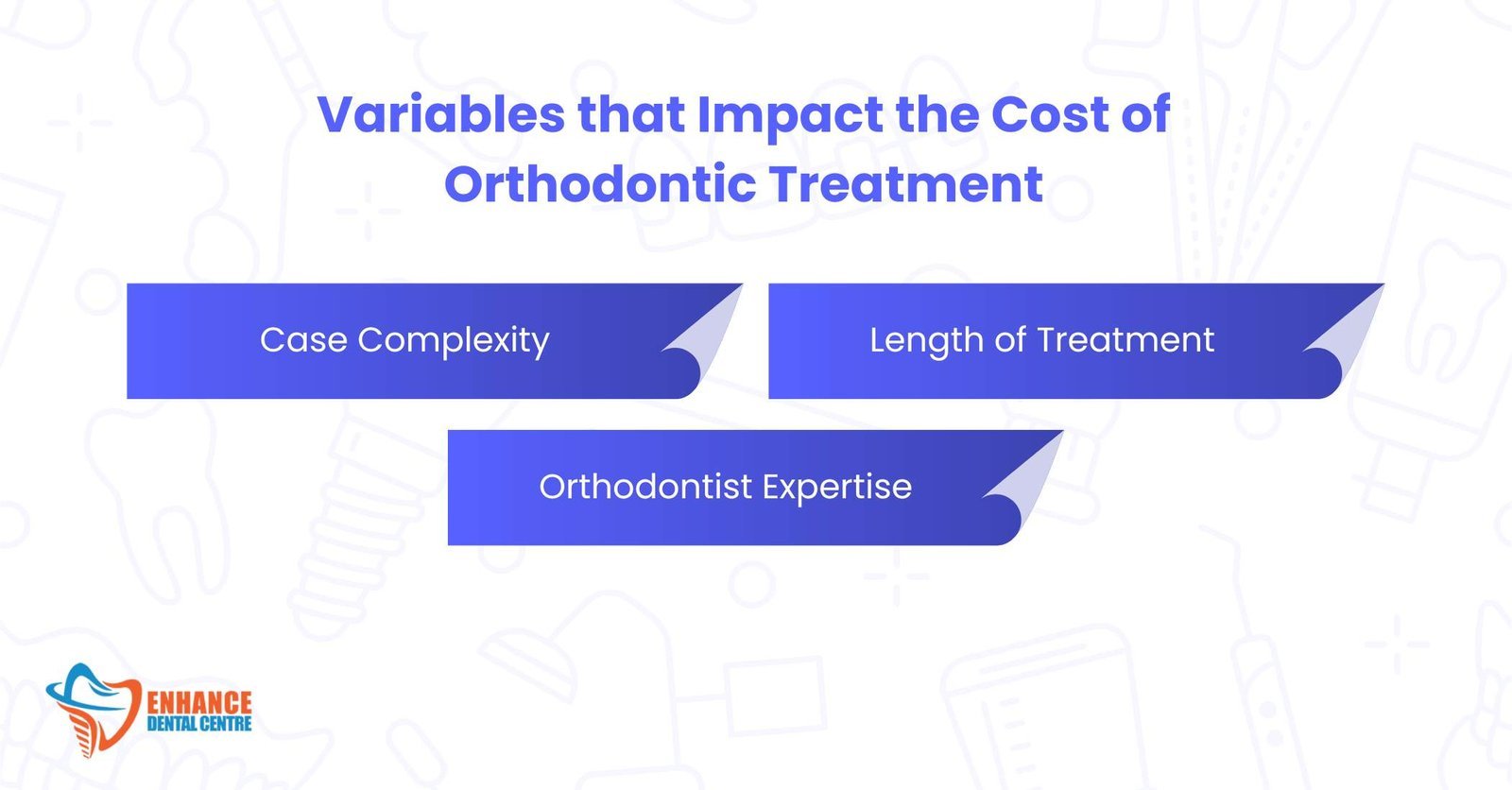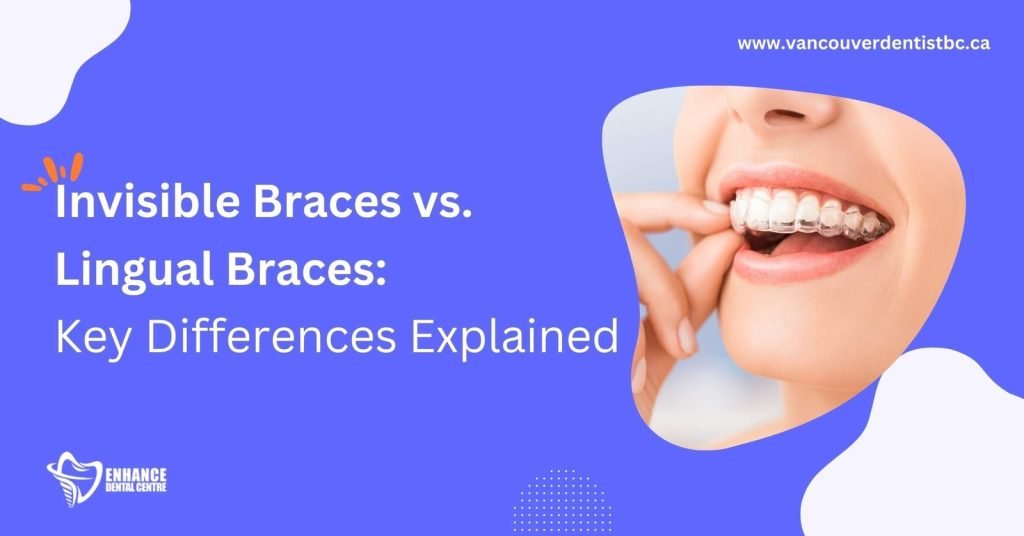Imagine smiling with confidence, knowing no one can tell you’re wearing braces. For adults and teens, options like invisible braces and lingual braces make this possible.
Gone are the days when straightening teeth meant metal brackets and wires. Today, you can align your teeth discreetly while maintaining a professional appearance or looking great in school photos.
But how do you choose between invisible braces and lingual braces? Both are excellent discreet options, but they cater to different needs, lifestyles, and budgets.
In this guide, we’ll explore the key differences between these orthodontic treatments to help you find the best solution for your smile goals. For a comprehensive overview of available options, visit Enhance Dental Centre orthodontic treatment options.
What are invisible braces and lingual braces?
Invisible braces and lingual braces are two popular choices for those seeking discreet orthodontic treatments. Both aim to straighten teeth with minimal visibility but differ in how they work. Let’s explore their unique features and processes.

Invisible Braces (Clear Aligners)
Invisible braces, also known as clear aligners, are transparent, removable trays designed to straighten teeth. These trays are custom-made from medical-grade plastic to fit snugly over your teeth.
How Invisalign Works
Invisalign is a common clear aligner brand that works by gradually moving specific teeth into their desired positions. Every two weeks, you switch to a new set of aligners, ensuring continuous progress throughout your treatment.
Key Features of Invisible Braces
- Nearly Invisible: Their clear design makes them ideal for professionals and teens who want subtle orthodontic treatment.
- Removable: You can easily remove them to eat, drink, and maintain oral hygiene.
- Custom-Fit: Each aligner is tailored for comfort and precision, ensuring a personalized treatment experience.
Lingual Braces
Lingual braces use traditional methods of brackets and wires, but with one major difference—they are placed on the back (tongue-facing side) of your teeth, making them completely invisible from the front.
How Lingual Braces Work
Lingual braces function similarly to traditional braces but with a hidden placement:
- Brackets and Wires: Custom brackets and wires are designed to fit the back of your teeth.
- Alignment: The braces apply gentle pressure to move teeth into the correct positions.
- Treatment Process: Regular adjustments by an orthodontist ensure the braces continue to guide your teeth effectively.
- Discreet Appearance: Because they are positioned behind the teeth, they are invisible from the front, offering unmatched discretion.
Key Features of Lingual Braces
- Completely Invisible: Ideal for individuals seeking maximum discretion.
- Fixed Design: Unlike aligners, they stay in place, requiring no daily effort to wear them.
- Not Removable: While less flexible than aligners, their permanence ensures consistent progress throughout treatment.
Invisible Braces vs. Lingual Braces Aesthetics and Visibility
When choosing orthodontic treatments, many patients prioritize how discreet their braces appear. Both invisible braces and lingual braces offer excellent solutions, but they achieve discretion in different ways.
Invisible Braces: Subtle Transparency
Visibility: Invisible braces, made from clear plastic, are nearly undetectable unless someone looks closely. Their transparency allows them to blend naturally with your teeth.
Best Settings: Ideal for social and professional environments, these aligners help you interact confidently without worrying about your appearance. Whether at work, events, or casual gatherings, invisible braces stay discreet and maintain your natural look.
Lingual Braces: True Invisibility
Visibility: Lingual braces offer complete invisibility from the front, as they are positioned behind your teeth. This makes them the ultimate choice for those who want their braces entirely hidden.
Best Settings: Perfect for individuals in public-facing roles, such as actors, speakers, or anyone frequently in photos or on camera. Lingual braces ensure no visible signs of orthodontic treatment, even in close-up shots.
Invisible Braces vs. Lingual Braces Comfort and Fit
When deciding between invisible braces and lingual braces, comfort plays a significant role. Both options have their pros and cons, particularly during the initial adjustment period.
Invisible Braces: Gentle and Removable
Invisible braces, or clear aligners, are designed to fit snugly and provide a comfortable experience. However, the edges of the aligners may cause minor irritation to your gums or cheeks when you first start wearing them. One of their key advantages is that they are removable, allowing you to take them out during meals or for short breaks, which can relieve any discomfort.
Lingual Braces: Fixed and Intrusive at First
Lingual braces are fixed to the back of your teeth, which can feel unusual initially. They may cause irritation or soreness on your tongue, and it’s common to develop a temporary lisp while your mouth adjusts. Eating and speaking may also feel awkward during the early stages as your tongue adapts to the brackets and wires.

Tips to Manage Discomfort
For Invisible Braces
- Apply orthodontic wax to smooth any sharp edges.
- Rinse your mouth with salt water to reduce irritation.
- Stick to a consistent wearing schedule to speed up the adjustment process.
For Lingual Braces
- Practice speaking to help your tongue adjust to the braces.
- Use orthodontic wax to protect your tongue from irritation.
- Eat soft foods during the adjustment period to minimize discomfort.
Both types of braces require a brief adjustment period, but with time and proper care, they become much easier to manage and more comfortable to wear.
Invisible Braces vs. Lingual Effectiveness
When considering effectiveness, invisible braces and lingual braces are suited for different orthodontic needs based on the complexity of the case.
Invisible Braces (Clear Aligners)
Clear aligners are highly effective for mild to moderate orthodontic issues, such as:
- Slight crowding
- Minor spacing issues
- Small bite adjustments
However, they are less suitable for complex cases like severe crowding, bite misalignments, or teeth rotation. This limitation arises because clear aligners depend heavily on the patient’s commitment. Aligners must be worn for 20–22 hours a day to ensure progress, and frequent removal can delay treatment.
Lingual Braces
Lingual braces, being fixed to the back of the teeth, are ideal for more complex orthodontic cases, including:
- Severe crowding
- Significant bite misalignments
- Rotational corrections
Because they are fixed, lingual braces ensure continuous correction without relying on patient compliance. This makes them better suited for intricate dental issues where precise and consistent pressure is required.
Key Takeaway
- Clear aligners are effective for simpler cases but depend on the patient’s discipline and consistent wear.
- Lingual braces are more effective for advanced cases, providing consistent results regardless of patient habits.
Note: It’s essential to consult an orthodontist to determine which treatment aligns best with your dental needs and goals.
How much do lingual braces cost compared to invisible braces?
Orthodontic treatments, such as invisible braces and lingual braces, vary in cost. Understanding the factors that influence pricing can help you plan your investment in a straighter smile.
Invisible Braces: Typically range between $3,000 and $8,000, depending on the complexity of the case and the brand you choose, such as Invisalign.
Lingual Braces: Generally cost more, ranging from $8,000 to $13,000. The higher price reflects the customization required for brackets that fit behind your teeth.
Factors Influencing Cost
Several variables impact the cost of orthodontic treatment, making it essential to understand what contributes to the final price. Here are the key factors that can affect the overall expense:

Case Complexity
Simple Cases: Mild alignment issues or spacing corrections cost less.
Complex Cases: Severe crowding, bite adjustments, or intricate alignments require more time and adjustments, increasing the overall cost.
Length of Treatment
Longer treatments mean additional aligners for invisible braces or more frequent adjustment visits for lingual braces, adding to the total expense.
Orthodontist Expertise
Orthodontists specializing in advanced treatments, such as lingual braces, often charge more due to their specialized training and experience.
Potential Hidden Fees
Beyond the base cost, both treatments may involve extra expenses:
- Invisible Braces:
- Replacement aligners for lost or damaged trays.
- Additional aligners for refinements to achieve the desired outcome.
- Retainers to maintain results after treatment (usually sold separately).
- Lingual Braces:
- Repairs for broken brackets or wires.
- Emergency visits for adjustments, which may not be included in the initial quote.
Takeaway: Invisible braces are generally more affordable and suitable for mild to moderate cases, while lingual braces offer a highly discreet option for complex cases but come at a higher cost.
Being aware of hidden fees and consulting your orthodontist can help you budget effectively and select the option that aligns with your needs and financial priorities.
Which Option Fits Your Budget
Choosing between invisible braces and lingual braces requires balancing your budget with your dental needs. Invisible braces are a cost-effective option for mild to moderate misalignments, offering flexibility and discretion. Lingual braces, while more expensive, provide complete invisibility and are ideal for addressing complex orthodontic cases.
Consider your treatment goals and lifestyle when deciding. For a more informed decision, consult with an orthodontist to determine which option best aligns with your budget and smile goals.
Treatment Duration for Invisible Braces and Lingual Braces
The duration of orthodontic treatment varies based on the complexity of your case and the type of braces you choose.
- Invisible Braces: Treatment typically lasts 6 to 24 months, with faster results for simpler cases like minor crowding or spacing issues.
- Lingual Braces: Treatment usually takes longer, ranging from 18 to 36 months, as they are designed to address more complex dental concerns, such as severe misalignments and bite corrections.
Regular orthodontic check-ups are essential for both options. These visits allow your orthodontist to monitor your progress and make adjustments as needed to keep your treatment on track.
Ideal Candidates for Each Treatment
Determining whether invisible braces or lingual braces suit your needs is essential for achieving the best results.
- Invisible Braces: These are ideal for adults and teens with mild to moderate misalignments, such as small gaps, slight crowding, or minor bite adjustments. They are also a great choice for individuals who prioritize a removable, low-maintenance option that offers flexibility in their daily routine.
- Lingual Braces: Best suited for individuals with complex dental issues, such as severe crowding, significant bite misalignments, or teeth rotation. Lingual braces are perfect for those who want completely hidden braces and are prepared to adapt to the initial adjustment period for maximum discretion.
Choosing the right treatment depends on your orthodontic needs, lifestyle, and priorities. Consulting with an experienced orthodontist can help determine the most suitable option for your unique smile goals.
Conclusion: Which Is Right for You?
Deciding between invisible braces and lingual braces depends on your unique needs, priorities, and lifestyle. Both options can help you achieve a straighter smile, but their features offer different advantages that may impact your treatment experience.
Aesthetics: If maintaining a natural appearance is your main concern, invisible braces are nearly undetectable and easy to remove, making them a flexible choice. Lingual braces, on the other hand, are completely hidden behind your teeth, ideal for those in public-facing roles or anyone who prioritizes full invisibility.
Comfort: Invisible braces generally provide more comfort due to their custom-fit design and removability, but they require discipline to wear consistently. Lingual braces may feel intrusive at first and require an adjustment period, but their fixed design ensures continuous progress without patient intervention.
Cost: Invisible braces are typically more affordable and work well for mild to moderate cases. Lingual braces are more expensive due to their customization and effectiveness for complex orthodontic needs, but they offer a level of discretion that may justify the higher cost.
Ultimately, the right choice should align with your orthodontic goals, lifestyle, and budget. Consulting with an experienced dentist is the best way to determine the option that suits your needs.
Are you ready to take the next step? Schedule a consultation with Enhance Dental Centre today, and let our experts guide you toward the smile you’ve always wanted. Learn more about our patients’ experiences by reading our patient testimonials and see how we’ve helped others achieve their dream smiles.

